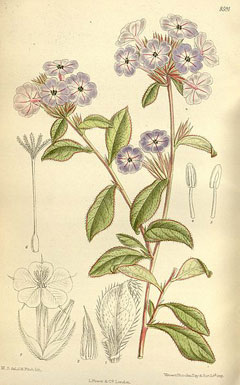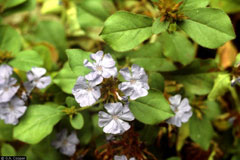 |
|
http://commons.wikimedia.org/wiki/File:Ceratostigma_willmottianum_140-8591.jpg |
 |
| G.A. Cooper @ USDA-NRCS PLANTS Database |
Translate this page:
Summary
Bloom Color: Blue.
Main Bloom Time: Early fall, Late summer. Form: Spreading or horizontal.
Physical Characteristics

 Ceratostigma willmottianum is a deciduous Shrub growing to 1 m (3ft 3in) by 1 m (3ft 3in) at a medium rate.
Ceratostigma willmottianum is a deciduous Shrub growing to 1 m (3ft 3in) by 1 m (3ft 3in) at a medium rate.
See above for USDA hardiness. It is hardy to UK zone 7. It is in flower from July to September. The species is hermaphrodite (has both male and female organs).
Suitable for: light (sandy) and medium (loamy) soils, prefers well-drained soil and can grow in nutritionally poor soil. Suitable pH: mildly acid, neutral and basic (mildly alkaline) soils and can grow in very alkaline soils.
It cannot grow in the shade. It prefers dry or moist soil.
UK Hardiness Map
US Hardiness Map
Synonyms
Plant Habitats
Woodland Garden Sunny Edge;
Edible Uses
References More on Edible Uses
Medicinal Uses
Plants For A Future can not take any responsibility for any adverse effects from the use of plants. Always seek advice from a professional before using a plant medicinally.
Bach
The plant is used in Bach flower remedies - the keywords for prescribing it are 'Distrust of self', 'Doubt of one's ability' and 'Foolishness'[209].
References More on Medicinal Uses
The Bookshop: Edible Plant Books
Our Latest books on Perennial Plants For Food Forests and Permaculture Gardens in paperback or digital formats.

Edible Tropical Plants
Food Forest Plants for Hotter Conditions: 250+ Plants For Tropical Food Forests & Permaculture Gardens.
More

Edible Temperate Plants
Plants for Your Food Forest: 500 Plants for Temperate Food Forests & Permaculture Gardens.
More

More Books
PFAF have eight books available in paperback and digital formats. Browse the shop for more information.
Shop Now
Other Uses
References More on Other Uses
Cultivation details
Landscape Uses:Border, Foundation. Prefers a light moderately fertile and retentive soil with good drainage, though it tolerates poor dry soils[200] and grows well on chalk[11]. Requires a sunny position[11, 200]. Plants are not fully hardy in Britain, especially if treated as shrubs, but if treated as herbaceous perennials they succeed outdoors in areas where winter temperatures do not fall below about -10 to -15°c[200]. When the woody stems survive the winter it is best to prune them hard in the spring in order to obtain better flowering[11]. Plants flower best on the current years growth[200]. Most, if not all the plants in cultivation in Britain, derive from an original two plants raised from seed in 1908[11]. Plants in this genus are notably resistant to honey fungus[200]. Members of this genus are rarely if ever troubled by browsing deer[233]. Special Features:
Blooms are very showy.
References Carbon Farming Information and Carbon Sequestration Information
Temperature Converter
Type a value in the Celsius field to convert the value to Fahrenheit:
Fahrenheit:
The PFAF Bookshop
Plants For A Future have a number of books available in paperback and digital form. Book titles include Edible Plants, Edible Perennials, Edible Trees,Edible Shrubs, Woodland Gardening, and Temperate Food Forest Plants. Our new book is Food Forest Plants For Hotter Conditions (Tropical and Sub-Tropical).
Shop Now
Plant Propagation
Seed - we have no details for this species but suggest sowing the seed in a greenhouse in the spring. When they are large enough to handle, prick the seedlings out into individual pots and grow them on in a greenhouse for at least their first winter. Plant them out into their permanent positions in late spring or early summer, after the last expected frosts. Division of rooted suckers in the spring[200]. Layering in the spring. Plants often self-layer[200]. Cuttings of half-ripe wood in a closed frame[200]. Plants should be overwintered in a frost-free frame or greenhouse for their first winter[200].
Other Names
If available other names are mentioned here
Native Range
TEMPERATE ASIA: China (Gansu Sheng (Wen Xian), Guizhou Sheng (west), Sichuan Sheng (s. & w.), Xizang Zizhiqu (southeast), Yunnan Sheng (east & north))
Weed Potential
Right plant wrong place. We are currently updating this section.
Please note that a plant may be invasive in one area but may not in your area so it's worth checking.
Conservation Status
IUCN Red List of Threatened Plants Status :

Growth: S = slow M = medium F = fast. Soil: L = light (sandy) M = medium H = heavy (clay). pH: A = acid N = neutral B = basic (alkaline). Shade: F = full shade S = semi-shade N = no shade. Moisture: D = dry M = Moist We = wet Wa = water.
Now available:
Food Forest Plants for Mediterranean Conditions
350+ Perennial Plants For Mediterranean and Drier Food Forests and Permaculture Gardens.
[Paperback and eBook]
This is the third in Plants For A Future's series of plant guides for food forests tailored to
specific climate zones. Following volumes on temperate and tropical ecosystems, this book focuses
on species suited to Mediterranean conditions—regions with hot, dry summers and cool, wet winters,
often facing the added challenge of climate change.
Read More
Expert comment
Author
Stapf.
Botanical References
11200266
Links / References
For a list of references used on this page please go here
Readers comment
| Add a comment |
|
If you have important information about this plant that may help other users please add a comment or link below. Only comments or links that are felt to be directly relevant to a plant will be included. If you think a comment/link or information contained on this page is inaccurate or misleading we would welcome your feedback at [email protected]. If you have questions about a plant please use the Forum on this website as we do not have the resources to answer questions ourselves.
* Please note: the comments by website users are not necessarily those held by PFAF and may give misleading or inaccurate information.
To leave a comment please Register or login here All comments need to be approved so will not appear immediately.
|
Subject : Ceratostigma willmottianum
|
|
|
|